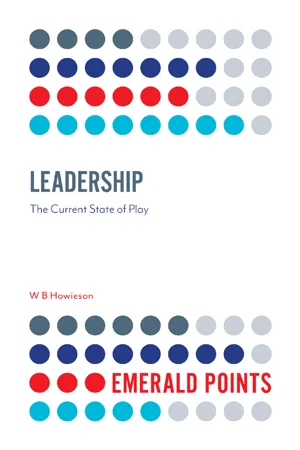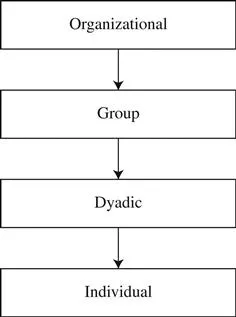![]()
CHAPTER 1
INTRODUCTION
BACKDROP
I think a lot about leadership. Indeed – and over the last 30 years – I have though a lot about leadership.
I recall in professional practice trying to be clear in my mind about many aspects of this subject. For example, several questions would come regularly to me:
- What exactly is leadership?
- How does one do it – in other words, is there a certain ‘way’ to do it?
- Is it a theory – in fact, I am not sure if I even understand what a leadership theory (or for that matter a theory) is?
- Is leadership a verb (i.e., a ‘doing’ thing) or a noun (a person, a place and an object)?
- Is it only Chief Executive Officers who do leadership – is this what strategic leadership means?
- Where does it take place? Indeed, why does it take place?
- Is it only the private/corporate sector that understand and do it? – for example, many leadership books seem to be written by corporate ‘gurus’.
I would now like to think that over the last 30 years – and having undertaken a PhD degree in the subject – and importantly, discussing it with many colleagues and indeed, postgraduate students and post-experience professionals that I understand the answers to these questions a lot more.
Of note, however, it would appear that it is not just me who asks questions such as these. For example, in 2013, a friend and colleague – himself a Leadership and Organisational Development Consultant – said to me that the problem with leadership (according to his many clients) was that ‘they did not know what it (leadership) was and how it (leadership) was translated into practice’.
This problem (what and how) was, then, the genesis of this short book.
This problem may be visualised in Figure 1.
In the present, and as a leadership academic, I am very interested in trying to keep abreast of the relevant leadership literature and trying to understand the latest ‘thinking’ in this subject. I do not, however, forget my 23 years of professional practice – prior to entering academia – when I tried to ‘do’ the subject on a daily basis. This is why I consider it very important that books such as these do not lose sight of the importance that practitioners at the coal face have in contributing to this subject and importantly, helping others understand how it is translated into practice. To this end, and in this short book, I am deliberately interested in examining both current leadership thinking (the what) and understanding the practice of leadership from a variety of practitioners in the private, public and third sectors in the United Kingdom today (the how).
At this stage, and to address the first question in Figure 1, I define a leadership position as when one has supervisory responsibility for other people. This may be as a Supervisor, Team Leader, Line Manager to Chief Executive, Board Director and Chairperson.
The purpose of this book, then, is to provide a theoretical and practical understanding of leadership in the second decade of this century for students of the subject and practitioners alike. I am, of course, reminded that a multitude of books on leadership has already been written.1 As an overview, it would seem to me that this literature can divided broadly into populist and academic categories:
- The populist genre includes a huge commercial market in management books on leadership and a circuit of celebrity for those who write them. Populist books range from the hero leader reflections and biographies to works by so-called gurus. Most books are written about, and by, well-known charismatic leaders accompanied by convincing stories and snappy sound bites. These books follow a similar vein, in that they espouse the ‘I did it my way’ approach and are often criticised for their lack of theoretical and methodological grounding. Such books provide an often-longed-for level of simplicity, yet – and of note – there is no evidence that they enhance the learning and success of leadership (Howieson & Hodges, 2016).
- In contrast, academic books on leadership (which include student-orientated texts, critical monographs and research studies) tend to posit leadership as a complex phenomenon and are often couched in language that the practitioner, I suggest, may find most impenetrable. In addition, this material can be overly theoretical, which may be difficult for many practitioners and, indeed, academics such as me to follow. These books do, however, provide extensive theoretical grounding but fail frequently to relate it to practical examples in the business world. Indeed, I get somewhat irritated by the many academic textbooks that do not give voice to the practitioners who are doing it (i.e., ‘leading’) at the coalface.
On the positive side, many of the above offerings do, however, make excellent reference guides and provide valuable suggestions for leaders in organisations.
AIM
Leadership: The Current State of Play is a short book about leadership. Its aim is to locate, in a single volume, current thinking in leadership from an academic and practitioner perspective. It offers an easy-to-read précis of leadership thought and its applications to problems in the second decade of this century.
The objectives of the book are threefold:
(1) To explore the theoretical and practical issues of leadership in organisations.
(2) To provide practical guidance for undergraduate and postgraduate students and post-experience professionals.
(3) To enable thinking, reflection and ‘self-conversation’ of leadership and importantly leading.
AUDIENCE(S)
This book will be of interest to undergraduate students (who are studying business and management), postgraduate students (from a variety of disciplines who plan management careers after graduation), post-experience professionals and a variety of practitioners in all sectors of the United Kingdom and beyond.
STRUCTURE
This book has four chapters:
(1) Introduction.
(2) What Is Leadership? – An Academic Perspective.
(3) How Does One Do It? – A Practitioner Perspective.
(4) Conclusion.
It is hoped that this structure will allow a ‘flow’ between developing a general appreciation of extant academic thinking and gaining an insight into how leadership is enacted (i.e., the leading) by practitioners. Throughout the book, the what and how will be offered in the context of an organisational setting.
Chapter 1: Introduction
In Chapter 1, I will offer a backdrop to the book, explain the purpose of the book – including its purpose, aim and audience – detail its structure and introduce the Leadership Matrix.™
Chapter 2: What Is leadership? – An Academic Perspective
In Chapter 2, I will provide an overview of the different academic thinking that exists currently about leadership. There are many scholarly (research) articles published annually on this subject – this chapter will not provide a meta-review and analysis of such material. Rather, it will draw from a variety of sources to probe and understand what we think we mean by leadership in the closing stages of the second decade of this century. In detail, the chapter will have the following sub-sections:
- Etymology and the Language of Leadership.
- The Definitional Problem.
- History of Leadership Research.
- A Key Debate.
- Leadership Models, Philosophies and Styles.
- Criticisms of the Mainstream Approach – Challenging the Western Hegemony.
- Its Difference to Management and Command (i.e., Being the Boss)
- Looking Ahead – The Next 30 Years.
Chapter 3: How Does One Do It? – A Practitioner Perspective
In Chapter 3, current practitioner literature (from, e.g., CIPD, Chartered Management Institute (CMI), The Economist, British Broadcasting Corporation (BBC) and the Royal Society of Arts (RSA)) will be reviewed to offer a summary of this current practitioner thinking. I will then compare this ‘thinking’ with the academic thinking – set out in Chapter 2 – where applicable and locate this practitioner thinking on the Leadership Matrix.™
Throughout Chapters 1–3, I will offer vignettes by leadership practitioners. These personnel are from the private, public and third sectors in the United Kingdom and work at the strategic, operational and tactical levels of organisations. In this way, this book is distinctive because it provides a focus on theory and practice, with an emphasis on the practical aspects of leadership across all sectors in the United Kingdom. The purpose of these vignettes is to complement the academic and practitioner thinking and to provide an opportunity for the voices of such individuals to be heard and who are rarely considered in such leadership literature. A broad cross-sample of people has been identified for the book – they have been asked to provide their candid views on leadership today and the challenges they face. These reflections, therefore, serve as an illustration of the benefit of approaching leadership through the eyes of those practicing leadership.
Chapter 4: Conclusion
In Chapter 4, a comparison will be made of the academic and practitioner literature. This thinking (academic and practitioner) will be located on the Leadership Matrix™ and general conclusions and reflections will be offered.
A WORKING FRAMEWORK: THE LEADERSHIP MATRIX™
Many leadership textbooks offer such sections on, for example: leadership and values; leadership and ethics; relational leadership; leadership and power; and leadership and culture. When I started thinking about the subject of leadership, such approaches would often confuse me. For example: where are values and ethics ‘located’ (is it, e.g., only senior executives who are concerned with values and ethics), is it sector-specific (does it only take place in (say) the private sector?) and is culture not part of leadership as opposed to it being something different, that is, an ‘add on’?
In this book, I will aim to address some of these approaches. Indeed, I have developed a working framework or Leadership Matrix™ that has helped me locate much of this current leadership thinking and helped me answer my many questions.
I proceed as follows. In his book Leadership in Organizations, Yukl (2013) conceptualises leadership at an individual process, a dyadic process, a group process and an organisational process. These levels can be viewed as a hierarchy, as depicted in Figure 2.
Figure 2: A Hierarchy of Leadership Levels.
Leadership conceptualised at a higher level usually assumes that related processes occur at lower levels, even although they are not explicitly described. For example, in a cohesive team (i.e., the group level) – with high mutual trust and cooperation – some assumptions can be made about the likely pattern of dyadic leader–member relationships and about each individual’s values, attitudes and perceptions (Yukl, 2013).2
A brief description of each level is as follows:
- Organisational: at this level, the focus is on the leadership as a process that occurs in a larger ‘open systems’ in which groups are sub-systems. Key areas at this level include strategic leadership and change in organisations.
Typical leadership questions – at this level – include:
- What is strategy?
- What, therefore, is strategic leadership?
- How do you influence group and dyadic level functions?
- How do you influence culture and change (if required)?
- How do you develop collective learning and innovative practice in your team?
Vignette 1 – by Paul Grice, Chief Executive of the Scottish Parliament – offers insight to leadership at this (organisational)...


